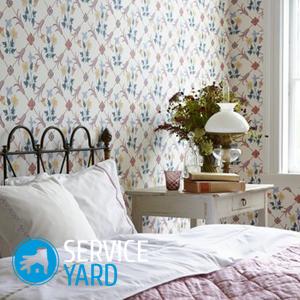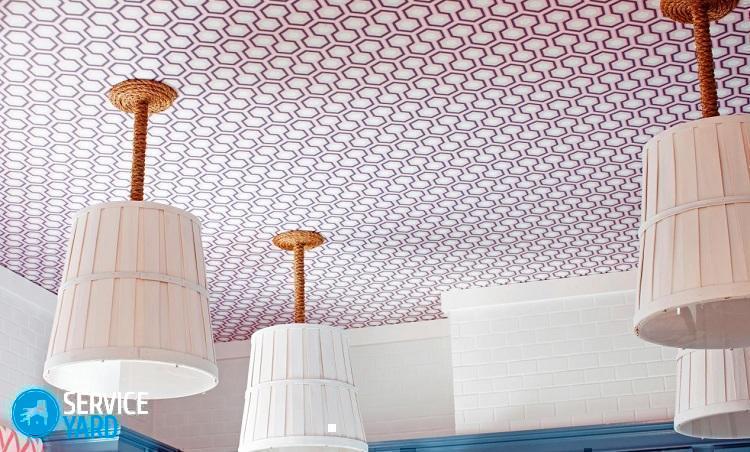How to glue wallpaper?

Wallpaper is one of the old and proven over the years finishing materials. Currently, the market offers many varieties of innovative materials that are easy to use and attractive in appearance. Therefore, the question of how to glue the wallpaper does not lose its relevance and does not lose for a long time. Numerous colors and textures, a variety of styles combined with affordable cost make this type of finish especially attractive to consumers. Useful tips outlined in the article will allow you to independently create a unique design.
to contents ↑Choice question
Wallpaper is a roll of cloth for wall decoration. In the manufacture of wallpaper, various materials are used. A standard wallpaper roll has the following parameters:
- Length - 10.0 m.
- Width 0.53 and 1.06 m.
Important! Additional functions of trellises are the improvement of heat and sound insulation of the room.
In accordance with the current standard, all wallpapers are divided into 3 main categories:
- Paper.
- Vinyl.
- Textile.
Important! Depending on the type of texture, profile, embossed, metallized, velor wallpapers are divided. Finishes from an untreated paper canvas decorated with natural materials look very nice. Wall murals are back in fashion. Embossed trellis can be two-layer, dyed or with rapport.
Paper
This is still a fairly common option. There are single and double layer wallpapers. The main advantages of the paper version are its low cost and environmental safety. The cloth glued to the walls allows air to pass through well.
But there are plenty of flaws too. This is the lack of water resistance and the accumulation of odors. The problem is partially solved by the use of duplex (two-layer) material, the top layer of which is moisture resistant.
Vinyl
Vinyl cloth has a base made of paper or non-woven and a protective polymer coating. This is a classic “washable wallpaper”, moisture resistant, solid and durable. Currently, practical and economical wallpaper for coloring has become very widespread. Most often they are made on a paper basis, but sometimes fiberglass is also used.
Important! Wallpaper for painting white. They can be painted several times. To change the color, water-based and latex dyes can be used.
Textile
They are named so because the basis of the canvas is fabric. In addition, there are special types of finishing materials on the market - bamboo or cork. Metallized wallpapers have a metallic natural layer or are painted “under the metal”.
Depending on the type of drawing, these types of trellis are distinguished:
- Background - coloring without drawing a picture.
- Embossed - a convex volumetric pattern is applied to the canvas.
- Primed - drawing a picture on a pre-painted canvas.
Wallpaper glue
The standard dry adhesive mixture based on modified starch allows high-quality gluing of wallpaper onto walls. The use of methyl cellulose additives improves adhesion, and antifungal and antiseptic compounds make the surface unattractive for the development of pathogens.
Wallpaper glue is sold in special packages. The powder is diluted with water, in accordance with the instructions.On average, 1 pack contains 4 to 5 liters of water. This is enough to glue 6-7 rolls with a width of 0.53 m. Water is poured into the container and an adhesive powder composition is added, stirring continuously. The resulting homogeneous solution without lumps is ready for use.
to contents ↑Glue wallpaper yourself - the necessary tools
Before you glue wallpaper, prepare such devices and tools:
- Paint roller.
- Putty knife.
- Brush.
- Sandpaper.
- Emery mesh.
- For marking - a ruler, a plumb line, a building level, a pencil.
- Screwdriver (for dismantling the covers of sockets).
- Scissors.
- Knife.
Wall preparation
First, the old wallpaper is completely removed. This can be done with a spatula or manually. So that the old coating is better behind the walls, it is pre-moistened with water for 10-15 minutes.
Important! Be careful when working with a spatula so as not to damage the plaster on the wall. If, nevertheless, the plaster layer was damaged, then dents and cuts should be covered with putty and wiped.
The wall intended for wallpapering needs to be primed over a layer of plaster. If you neglect the application of a primer, there is a risk of dusting the surface, and the quality of adhesion will significantly deteriorate.
Important! If there is no special primer mixture, then a solution of PVA glue in water can perfectly replace it.
The walls are thus smooth and even. You can start gluing the walls only after the wall is completely dry.
to contents ↑Markup
Before you begin to glue the wallpaper, mark their upper border. This is true if the canvas is not glued flush to the ceiling. For this:
- Measure the required distance from the ceiling and make appropriate marks in the corners.
- Then, using a building cord, draw straight lines along the walls around the entire perimeter of the room.
- It is also recommended to draw vertical lines on the walls with a meter spacing. This makes it possible to control the vertical gluing of the panels. Vertical marking is done using a building plumb.
Calculate the number of wallpapers required for one wall. The pattern is aligned on the first strip pasted on the wall. The second strip is cut so as to properly align the pattern. In this case, it is natural that part of the wallpaper will go to waste. The sheets are numbered and stacked in order.
to contents ↑How to glue the wallpaper?
Before starting work, the windows are closed so that there are no drafts:
- The first wallpaper is glued to the wall, stepping away from the corner by a distance of 200-250 mm. The glue is applied to the wallpaper with a brush or roller.
- Glue the first strip, guided simultaneously by two markings - vertical and horizontal. After the canvas is fixed, a roller or a special plastic “wing” pass along the surface, squeezing air.
Important! Roll the wallpaper with a roller several times, and the direction of rolling resembles a “herringbone”. There should be no bubbles or wrinkles on the canvas. The wallpaper, including the side edge, should fit snugly against the wall.
- The remaining panels are glued in the same way. At the same time, both compliance with the markup and the coincidence of the pattern are carefully monitored. Gluing strips produce butt.
Important! Before gluing the tapestries, disconnect the sockets and switches and disconnect the decorative cover from them.
- After the cloth is glued in the area of an electric point, a circle is cut in the wallpaper. The diameter of the circle must be such that it is smaller than the dimensions of the cover of the outlet or switch. In this case, after mounting the cover of the electric point, the circle boundary will be hidden.
Features gluing corners:
- An angular strip is placed end-to-end to the first web and placed on an adjacent wall.
- Then paste part of the strip located on the first wall.
- In the canvas, a section is cut under the windowsill. It is best to act with a knife.
- The line bordering the window opening is also cut with a knife.
- The pasting of the surfaces behind the heating radiator, above the window and door is carried out according to the same principle as conventional wall decoration. Cut off the strip of wallpaper of the appropriate size and paste butt to the already mounted strip.
Additional tips
They will help you in your work in order to quickly and accurately glue the wallpaper yourself:
- Wallpapering preferably with an assistant. One person works at the top, controlling the line of restriction, the other is at the bottom and monitors the vertical. Sticking wallpaper on the wall with your own hands will go much faster.
- Apply glue to the wallpaper cloth on a horizontal surface. For convenience, the strip can be folded in half, but in no case do not bend.
- After the glue is applied to the canvas, do not rush to glue it instantly. It is advisable to wait 5-10 minutes for the composition to soak the trellis.
- Installation of non-woven wallpaper has its own specifics. The direction of surface gluing is from window to door. If glue gets on the front surface, it must be wiped immediately.
Stock footage
As you can see, the answer to the question of whether it is difficult to glue the wallpaper is negative. It is only important to act carefully and without rushing.
- How to choose a vacuum cleaner taking into account the characteristics of the house and coatings?
- What to look for when choosing a water delivery
- How to quickly create comfort at home - tips for housewives
- How to choose the perfect TV - useful tips
- What to look for when choosing blinds
- What should be running shoes?
- What useful things can you buy in a hardware store
- Iphone 11 pro max review
- Than iPhone is better than Android smartphones




